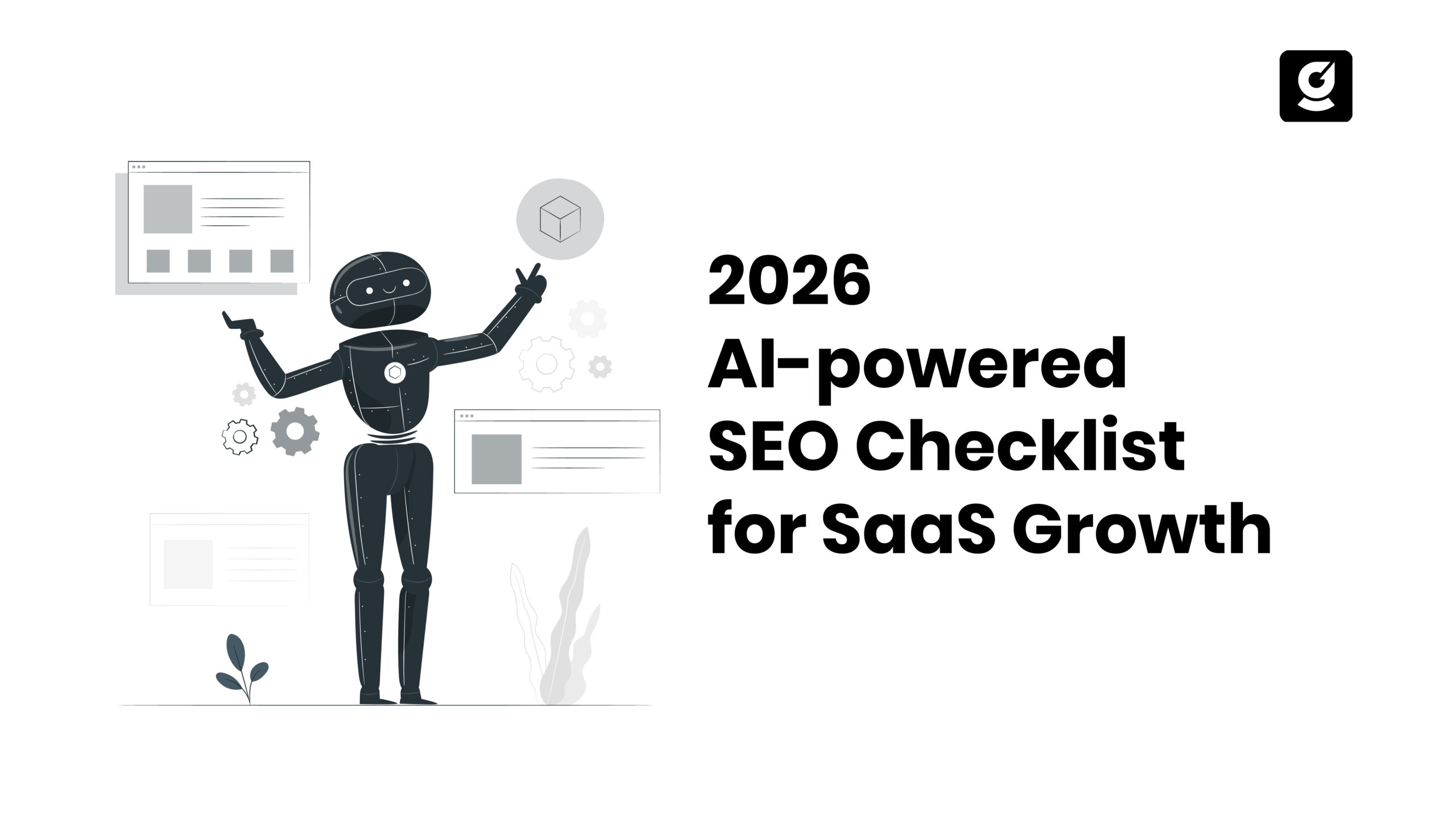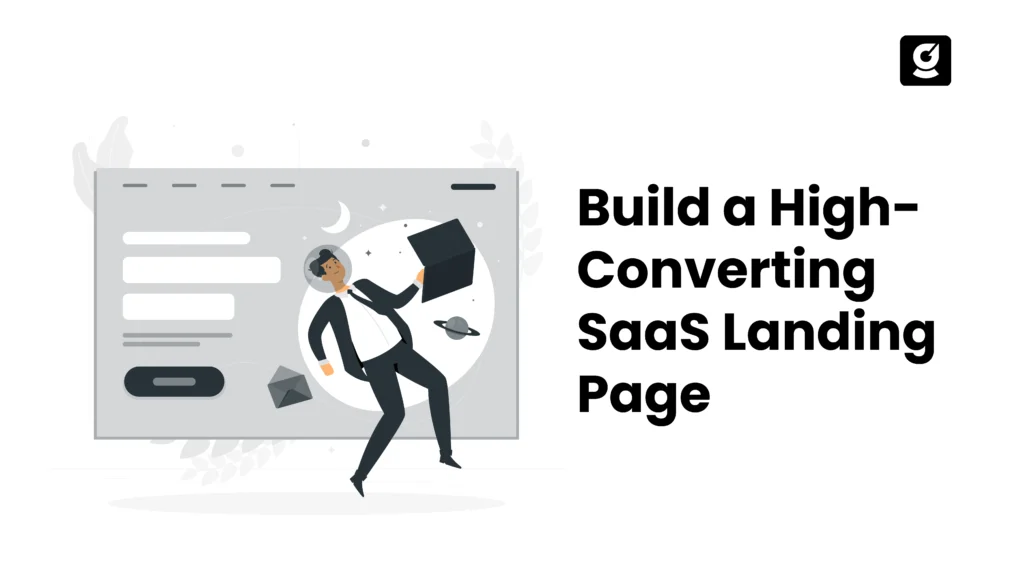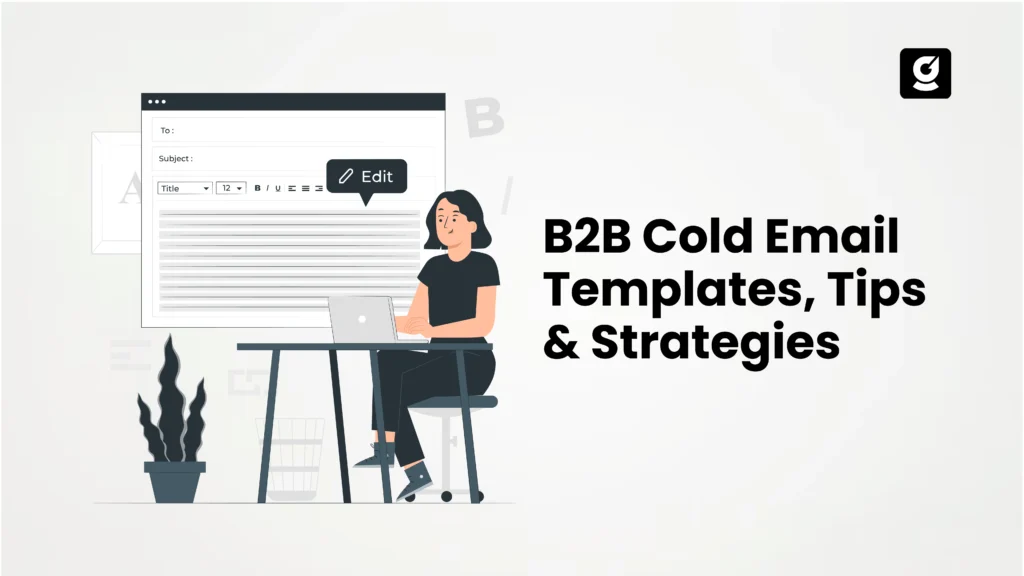The AI shift in SaaS is already happening:
- As of 2025, a whopping 68% of businesses are actively changing their strategies in response to AI search—and with it, competition is getting steeper.
To outrank, outreach, and outperform in global SaaS markets, you need every single advantage you can get now, more than ever.
But the problem with most SaaS companies? Manual SEO can no longer keep up. Relying solely on manual SEO puts your team at a major disadvantage.
This comprehensive AI SEO checklist is designed precisely to address these gaps in traditional SEO. It includes easy-to-implement, actionable steps for global SaaS brands like yours to scale growth in 2025.
But what happens when you don’t invest in AI-powered SEO soon? What’s the real cost of ignoring this shift?
Outdated SaaS SEO Costs You Traffic, Revenue, and Authority
Not investing in AI-powered SEO in 2025? Here’s what you risk:
- Traffic & Revenue Loss: Up to 20-30% lower traffic as your competitors capture long-tail and localized searches.
- Resource Drain: Manual efforts result in 3x higher time spent, increased technical debt, slower site speed, and higher bounce rates.
- Poor Authority Signals: Outdated E-E-A-T (Expertise, Experience, Authority, Trust) signals can damage rankings as Google demands more transparent, authoritative formats.
In short: you’re wasting budget, missing growth, and damaging your competitive positioning exactly when markets demand faster, more competent SaaS SEO services.
Why AI SEO is Essential for SaaS in 2026?
An AI SaaS SEO strategy directly addresses the core issues in traditional SEO methods, turning your challenges into opportunities.
By leveraging AI, you can:
- Scale localization seamlessly by clustering intent by region.
- Adapt to algorithm changes via real-time analysis.
- Target revenue-driving terms by grouping high-intent keywords.
- Ease your team’s workload through auto-optimization and auditing.
- Boost authority signals with automated schema and optimized content formats.
The shift to AI isn’t just about efficiency—it’s about survival.
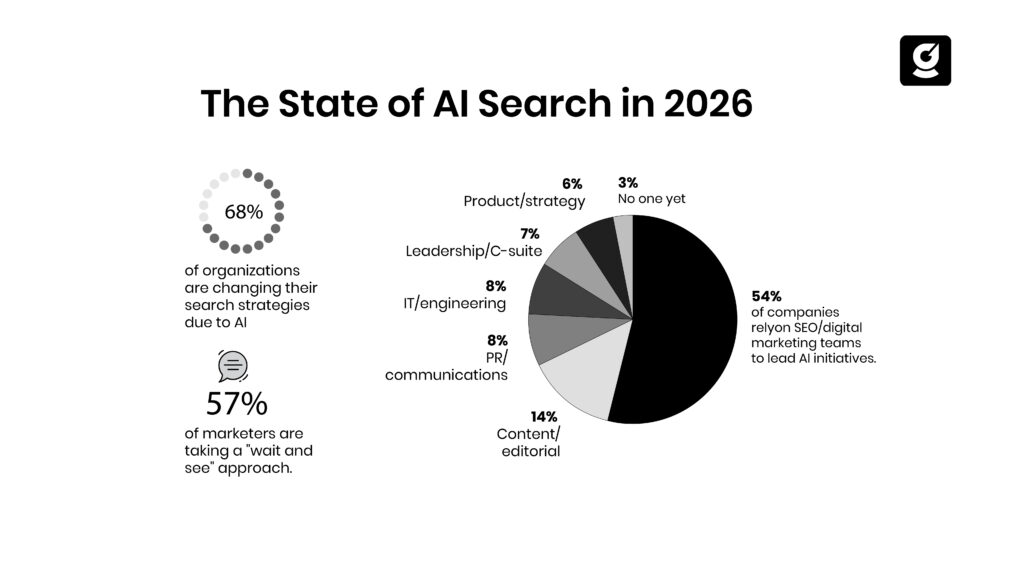
The Ultimate AI SEO Checklist for Global SaaS Brands
Use this checklist for rapid execution, whether you’re a founder, SaaS CMO, or an in-house marketer.
1. AI‑Driven Keyword Research & Global Localization
AI platforms now detect user intent across regions, cluster related keywords, and scale multi-language keyword discovery effortlessly.
- Keyword & Localization Checklist:
Intent clustering:
Group keywords into awareness, comparison, and conversion intent. AI surfaces patterns humans miss.
Process: AI tools analyze a list of keywords and the top 10-20 search results for each.
- If similar URLs rank for multiple keywords, the AI determines they share the same user intent and can be targeted with a single piece of content.
Example: While a human might group “how to build a website,” “best website builders,” and “website builder tutorial” as related, AI would categorize “how to build a website” and “website builder tutorial” as informational, and “best website builders” as commercial, suggesting distinct content types (e.g., a tutorial vs. a review).
Competitor gap analysis:
Analyze regional competitors and identify content gaps your AI tool can fill.
Process: AI tools crawl your domain and competitors’ sites to compare keyword portfolios.
- Identifying keywords where competitors rank on the first page but you don’t.
- They also analyze content intent and topic clusters to uncover missed areas.
Example: If you run a finance blog, AI might find a competitor ranking for “cryptocurrency taxes” while you lack content on it, highlighting a key content gap to target.
Localized term mining
Use AI to uncover regional variants (e.g., “cloud accounting India”), industry slang, and colloquialisms.
Process: AI analyzes search trends and SERP data to identify regional variants of broad topics, like “cloud accounting,” and uncover local terms, slang, or industry jargon.
Example: AI might find that in the UK, “petrol” is standard, while in the US, “gasoline” is used. For a car parts company, this is crucial for localization. Similarly, for a B2B service, “tech business growth” might be more popular than “B2B SaaS marketing” in certain regions.
Real-time performance monitoring:
Utilize AI dashboards to track keyword movement and make adjustments in real-time.
| Your Keyword Research & Global Localization To-Do List: |
| ✅ Use AI tools (e.g., Semrush, Clearscope) to cluster keywords by topic, intent, and funnel stage. ✅ Identify high-converting, buyer-ready terms for each target geography. ✅ Use NLP tools to analyze local search trends in the native language. ✅ Uncover competitor keyword gaps using AI-driven market intelligence. ✅ Monitor keyword shifts and SERP volatility in real-time. |
2. AI‑Powered Technical SEO: Core Web Vitals to Schema
Technical issues in global SaaS platforms can significantly impact rankings; AI identifies and prioritizes these issues faster and more effectively.
- AI SEO audit checklist:
Automated crawl audits:
AI flags broken links, duplicate pages, and redirect chains.
DeepCrawl and Screaming Frog: These crawlers have integrated AI to audit large websites more intelligently. They can identify complex crawl issues, such as JavaScript-rendered content problems, broken links, and sophisticated redirect chains.
Core Web Vitals recommendation engine:
LCP, INP, and CLS optimizations prioritized by impact and effort.
Process: AI analyzes a page’s code and assets to identify the key element affecting LCP.
- It then models optimizations (e.g., image compression, WebP conversion, script deferring) and ranks them by impact and development effort.
Example: For a blog, AI might identify a hero image as the main issue. It would suggest three options:
1) Compress the image,
2) Convert to WebP, or
3) Lazy-load it,
Ranking them by the best performance gain with the least effort.
Schema generation:
Automatically generate and deploy FAQ, product, and organization schema across pages.
Process: AI uses NLP to understand page content, identify key elements (e.g., product names, prices), and automatically generate and validate JSON-LD schema for Google’s rich snippets.
Example: For a product page, AI generates a Product schema with details like price and reviews, potentially leading to rich results in the SERPs. For an FAQ page, it creates an FAQPage schema from the questions and answers.
Duplicate content detection:
AI reconciling canonical chains or suggesting rewrites.
| Your Technical SEO To-Do List: |
| ✅ Run AI-driven site audits to fix crawl issues, duplication, or orphan pages. ✅Optimize LCP, CLS, and INP scores using predictive load testing tools. ✅Use AI to generate dynamic, accurate schema markups (FAQ, product, org). ✅Ensure AI-optimized image formats (WebP), compressed assets, and responsive design. ✅Resolve duplicate content with auto-suggestions or canonicalization. |
3. Intelligent On‑Page Optimization with AI Enhancements
On-page structure and metadata are now AI-optimized—with less guesswork and higher click-through rates.
- AI SEO audit checklist for On Page :
SEO-friendly URLs
These are auto-generated with relevant keywords and a simple structure.
Title tags & meta descriptions:
AI suggests info-rich, CTR-optimized text within character limits.
Process: AI suggests multiple title tags and meta descriptions using NLP, focusing on compelling language, power words, and character limits.
- It may recommend A/B testing for optimal performance.
Example: For a headphone product page, AI might suggest a more persuasive meta description like, “Experience studio-quality sound with top-rated headphones. Get crystal-clear audio and a comfortable fit. Shop now for a limited-time offer!”
Content readability:
AI ensures flow—short sentences, hierarchical headings, bullet points.
Process: AI editors scan content, provide a readability score, highlight complex sentences, and suggest simplifications.
- It also checks heading structure (H1, H2, H3) for better scannability and user experience.
Image optimisation:
Automatic WebP conversion, AI-generated alt tags, and compressed dimensions.
Optimizing images for SEO is a tedious but crucial task that AI can largely automate.
Process: AI automatically converts images to efficient formats like WebP and uses computer vision to generate descriptive alt tags for accessibility and SEO.
Case Study: The New York Times
While the New York Times has not publicly detailed a single AI-on-page case study, they have publicly discussed its use of AI for internal linking, a critical on-page factor.
- Result: The NYT’s AI system suggests relevant internal links, improving their link architecture, boosting traffic to older content, and speeding up indexing. Automating this task has enhanced user engagement and content rankings, key to their digital strategy.
| Your AI-Enhanced On-Page SEO To-Do List: |
| ✅ Generate keyword-rich, human-readable meta titles and descriptions with AI. ✅ Use a clear H1-H4 heading structure for better readability. ✅ Create short, relevant, SEO-friendly URLs using AI. ✅ Optimize images with AI-generated alt text, compression, and WebP format. ✅ Ensure content is readable and accessible with AI-powered checks. |
4. Content Creation & Strategy Powered by LLMs
LLMs empower ideation, topic mapping, and even draft creation—while your human team polishes for tone and trust.
- LLM SEO Content Strategy Checkpoints:
Topic ideation:
AI analyzes competitor content and search intent to suggest new verticals.
Cluster and pillar structure:
Organize a pillar page and subtopics that AI connects via internal links.
Process: AI analyzes a broad keyword to identify subtopics and organizes them into a pillar page with supporting cluster articles.
- This structure helps establish topical authority.
Example: AI might suggest a pillar page on “SEO for Beginners” and generate cluster articles like “Understanding Long-Tail Keywords” and “How to Do a Site Audit,” all linking back to the pillar. This strategy boosts the site’s authority on the topic.
Draft generation:
AI creates structured outlines with headings and key points. Human editors ensure voice and authority.
E‑E‑A‑T reinforcement:
Include author bios, quotes, third-party citations, and case study data.
Process: AI generates a draft and suggests where to add data, citations, or expert quotes.
- The human editor enriches it with real examples, insights, and sources to ensure E-E-A-T.
Example: An AI draft on financial planning may mention “diversifying your portfolio,” and the editor would add expert quotes, studies, and personal anecdotes for credibility.
Suggested read: How to Structure SaaS Content for Maximum SEO & Conversions
| Your LLM Optimised Content Creation To-Do List: |
| ✅ Use tools like ChatGPT for topic ideation and outline generation. ✅Create content clusters: pillar pages with supporting articles. ✅Leverage AI to identify content gaps and repurpose high-performing assets. ✅Maintain EEAT by enriching content with expert quotes, data, and bios. ✅Run AI-driven SERP analysis to optimize for featured snippets. |
5. AI‑Boosted Link Building & Off‑Page SEO
AI identifies backlink opportunities faster, personalizes outreach, and helps monitor brand authority.
- AI SEO checklist:
Competitor backlink analysis:
Identify high-authority domains linking to competitors.
Process: AI analyzes competitor backlinks to identify high-quality sources and filter out irrelevant links, providing a prioritized list of top opportunities.
Example: The AI might find that a competitor earned backlinks from top-tier blogs or resource pages and suggest similar sites for your link-building strategy.
Automated outreach segmentation:
AI crafts personalized messages tailored to each prospect.
Process: AI uses NLG to create personalized email intros, pulling details like names and recent articles for a unique touch.
Example: Instead of a generic “Hello,” AI might say, “Hi [First Name], I loved your article on [Topic] and think my resource on [Your Resource] would be a great fit for your readers.”
Brand mention tracking:
AI surfaces unlinked mentions to pursue backlinks.
Linkable asset creation:
Data reports, interactive tools, and infographics that AI suggests based on search demand.
Suggested read: SaaS Link Building: What Really Works in 2025?
| Your Link Building & Off‑Page SEO To-Do List: |
| ✅ Identify high-authority backlink opportunities via AI-powered crawlers. ✅Automate and personalize outreach using natural language generation. ✅Track brand mentions in AI tools and convert them into backlinks. ✅Build linkable assets (e.g., tools, whitepapers) tailored by predictive topic models. ✅Analyze and replicate competitor link profiles. |
6. Performance Tracking & Scaling with AI
AI doesn’t just optimize—it predicts. Use it to order tasks, forecast trends, and escalate wins.
- AI SEO Performance Tracking Checkpoints:
Real-time dashboards:
Track crawl errors, SERP shifts, and backlink health instantly.
Predictive analytics:
Forecast emerging keywords, ranking risks, and opportunities.
Process: AI analyzes ranking data, search trends, and competitor behavior to predict keyword growth, at-risk pages, and new opportunities.
Example: AI might predict a supporting article’s ranking will decline unless updated, and identify a new long-tail keyword with high search potential.
Action prioritization:
AI ranks recommendations by impact on conversion KPIs.
Process: AI assigns an impact score to SEO tasks based on factors like traffic potential, conversion rate, and effort. It prioritizes tasks for maximum ROI.
Example: Instead of 200 crawl errors, AI might highlight three high-value issues on key pages, prioritizing them for immediate ranking and traffic improvement.
Team augmentation:
Scale execution with agency or internal resources using AI-generated frameworks.
| Your AI SEO Performance Tracking To-Do List: |
| ✅ Monitor rankings, CTRs, and crawl issues in real-time. ✅Use predictive AI tools to forecast performance trends. ✅Prioritize tasks based on impact scoring (LTV, conversions, traffic potential). ✅Scale execution with AI-integrated SEO agencies or platforms. ✅Build dashboards with actionable insights, not just data dumps. |
Read more: The Definitive Guide to LLM-Optimized SaaS SEO (+Checklist)
10‑Step Roadmap for Implementing SaaS SEO Checklist (By growth.cx)✅
Curious how this checklist deploys in practice?
Our growth.cx SaaS SEO framework combines AI automation, human expertise, and a clear process. Check out how Visitly achieved an 88% organic traffic surge and a 131% boost in impressions in just 8 months.
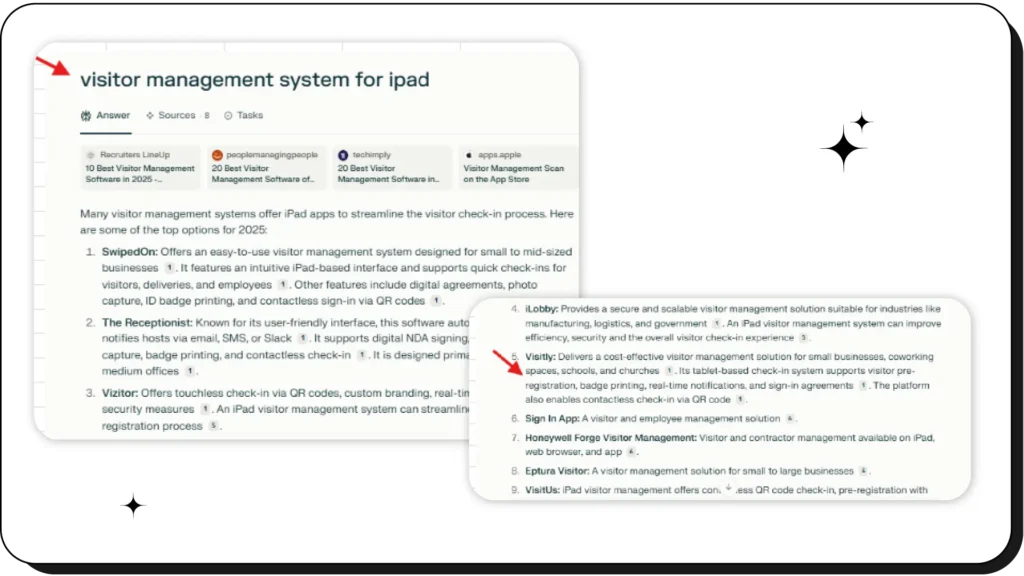
How will growth.cx implement this AI SEO checklist into your SaaS roadmap?
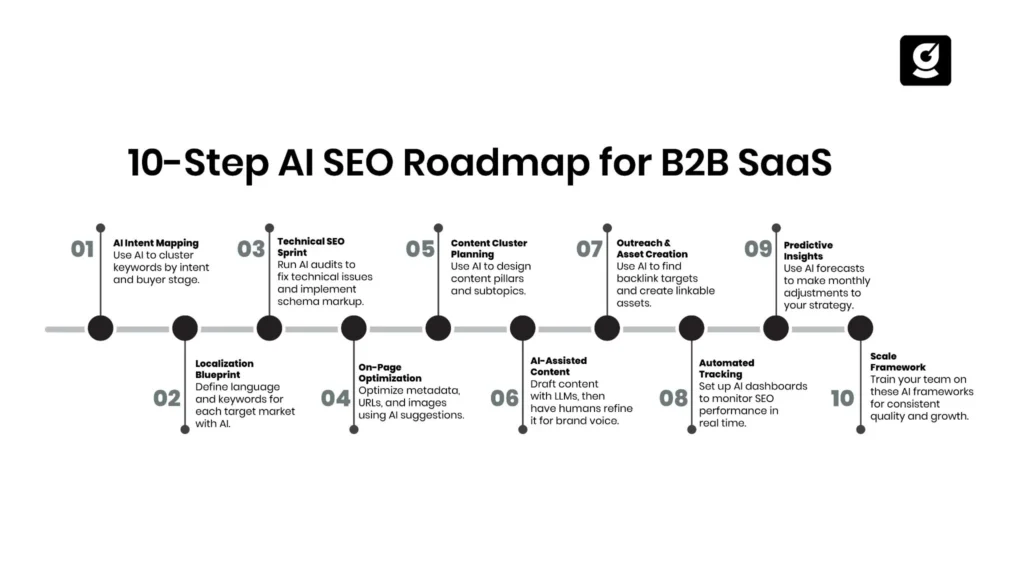
Implement This AI SEO Checklist to Fast Track Your SaaS Growth
You’ve seen how AI is redefining SaaS SEO strategy for global brands—delivering faster insights, broader reach, and smarter content that converts every stage of the funnel.
As a leading SaaS marketing agency, growth.cx helps businesses leverage AI at every stage, from keyword discovery to performance tracking, ensuring each step compounds into long-term organic growth. By following this checklist and growth.cx’s 10-step roadmap, you empower your team to scale SEO without guesswork, increase visibility across markets, and reclaim growth efficiency.

Frequently Asked Questions (FAQs)
Is AI SEO too technical for our SaaS team?
Not at all. Growth.cx’s frameworks abstract complexity—your team focuses on strategy and voice, while AI handles the heavy lifting in research, optimization, and monitoring.
Isn’t the B2B SaaS market too niche for AI?
That’s precisely where AI excels. It quickly finds and clusters hyper-niche search terms—terms that manual research would otherwise overlook. You can dominate niche verticals faster.
How can AI improve our SaaS SEO strategy?
AI streamlines keyword research, optimizes content, and analyzes competitors, helping you build a stronger, more scalable SEO strategy tailored to your SaaS business.
What’s the benefit of an AI SEO audit checklist for SaaS?
An AI-driven SEO audit checklist provides actionable insights, identifies SEO gaps, and prioritizes tasks based on their impact on traffic and conversions, helping you optimize your SaaS website for better performance.
